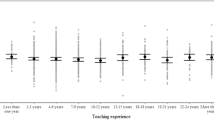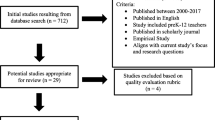Abstract
Scientific problems of the twenty-first century involve complex research questions that require an interdisciplinary approach. Educational research suggests that overall student achievement is greater in an interdisciplinary science curriculum than in a discipline-specific science curriculum. Regardless, the secondary school science curriculum in Ontario remains discipline-specific. The Ontario Ministry of Education (OME) released an ‘Interdisciplinary Studies’ curriculum in 2002; however, it appears to be sparsely implemented across Ontario. The objective of this study is to investigate what guidelines are provided by the OME to help Ontario secondary school science teachers (grades 11–12) design and implement interdisciplinary science courses. A document analysis methodology is used to gather data from selected OME curriculum documents. The results of this study found that interdisciplinary science courses are based on multiple models of interdisciplinarity; however, the guidelines provided for developing interdisciplinary curriculum, assessment, and teaching methods do not explicitly indicate which type of interdisciplinary model is applied, nor do the documents explicitly consider the degree of integration of concepts and skills from across disciplines/subject areas. Primarily, the results of this study may inform Ontario Ministry science curriculum writers, teachers and educators interested in interdisciplinary science curriculum elsewhere, about what aspects of the selected curriculum documents provide practical information for developing interdisciplinary science courses and components of the curriculum that may warrant potential revisions or additions during future curriculum drafting.
Résumé
Les problèmes scientifiques du XXIe siècle soulèvent des questions de recherche complexes qui nécessitent une approche interdisciplinaire. Les recherches en pédagogie indiquent que le rendement général des élèves est meilleur dans un programme de sciences interdisciplinaire que dans un programme de sciences spécifique à chaque discipline. Pourtant, le curriculum scientifique dans les écoles ontariennes reste centré sur des programmes à une seule discipline. Le ministère de l’Éducation de l’Ontario (MEO) a publié en 2002 un programme d’études intitulé « Études interdisciplinaires », mais celui-ci semble avoir été peu appliqué dans toute la province. L’objectif de cette étude est d’examiner les lignes directrices fournies par le MEO pour aider les enseignants de sciences au secondaire en Ontario (11e et 12e année) à créer et à proposer des cours de sciences interdisciplinaires. Une méthodologie d'analyse de documents est utilisée pour recueillir des données tirées d’une série de documents choisis provenant des programmes d'études du MEO. Les résultats de cette étude montrent que les cours de sciences interdisciplinaires sont basés sur plusieurs modèles d'interdisciplinarité; cependant, les directives fournies pour l'élaboration de programmes, de modèles d’évaluation et de méthodes d'enseignement interdisciplinaires n'indiquent pas explicitement le type de modèle interdisciplinaire appliqué, et les documents ne prennent pas explicitement en compte le degré d'intégration des concepts et des compétences provenant des différentes disciplines. Essentiellement, les résultats de cette étude peuvent renseigner les enseignants et les concepteurs des programmes de sciences de l’Ontario, de même que les éducateurs qui s’intéressent aux programmes interdisciplinaires en sciences appliqués ailleurs dans le monde, d’une part sur les aspects particuliers des documents analysés qui sont susceptibles de fournir des informations pratiques pour la création de cours de sciences interdisciplinaires, et d’autre part sur les éléments du curriculum qui pourraient justifier d'éventuelles révisions ou des ajouts lors de l’élaboration de futurs programmes.


Similar content being viewed by others
References
Augsburg, T. (2005). Becoming interdisciplinary: An introduction to interdisciplinary studies. Dubuque: Kendall/Hunt.
Boix Mansilla, V. (2005). Assessing Student Work at Disciplinary Crossroads. Change: The Magazine of Higher Learning, 37(1), 14-21. doi: https://doi.org/10.3200/CHNG.37.1.14-21
Bowen, G. A. (2009). Document analysis as a qualitative research method. Qualitative Research Journal, 9(2), 27-40.
Brown, S.A. (1977). A review of the meanings of, and arguments for, integrated science. Studies in Science Education, 4, 31-62. https://doi.org/10.1080/03057267708559845
Bybee, R.W. & Fuchs, B. (2006). Preparing the 21st century workforce: A new reform in science and technology education. Journal of Research in Science Teaching, 43(4), 349-352. https://doi.org/10.1002/tea.20147
Calgoni, A., & Eyles, C. H. (2010). A new approach to science education for the 21st century. Educause Review, 45(1), 1-4.
Chowdhary, B., Liu, X., Yerrick, R., Smith, E., & Grant, B. (2014). Examining science teachers’ development of interdisciplinary science inquiry pedagogical knowledge and practices. Journal of Science Teacher Education, 25, 865-884. https://doi.org/10.1007/s10972-014-9405-0
Ciesielski, T. H., Aldrich, M. C., Marsit, C. J., Hiatt, R. A., and Williams, S. M. (2017). Transdisciplinary approaches enhance the production of translational knowledge. Translational Research, 182, 123-134.
Council of Ministers of Education, Canada (CMEC; 1997). Common Framework of Science Learning Outcomes K-12. Retrieved from http://science.cmec.ca/index.en.htm
Czerniak, C. (2007). Interdisciplinary science teaching. In S.K. Abell & N.G. Lederman (Eds.), Handbook of research on science education (pp. 537-559). Mahwah: Lawrence Erlbaum Associates.
Fuchsman, K. (2009) Rethinking integration in interdisciplinary studies. Issues in Integrative Studies, 27, 70-85.
Guzey, S., Moore, T., & Harwell, M. (2016). Building up STEM: An analysis of teacher developed engineering design-based STEM integration curricular materials. Journal of Pre-College Engineering Education Research, 6(1), 11-29. https://doi.org/10.7771/2157-9288.1129
Hodson, D. (1992). In search of a meaningful relationship: An exploration of some issues relating to integration in science and science education. International Journal of Science Education, 14(5), 541-562. https://doi.org/10.1080/0950069920140506
Hsieh, H-F. and Shannon, S.E. (2005). Three approaches to qualitative content analysis. Qualitative Health Research, 15(9), 1277-1288.
Hurd, P., DeHart (1975). Science, technology, and society: new goals for interdisciplinary science teaching. The Science Teacher, 42(2), 27-30.
Hurley, M. M. (2001). Reviewing integrated science and mathematics. The search for evidence and definitions from new perspectives. School Science and Mathematics, 101(5), 259-268. https://doi.org/10.1111/j.1949-8594.2001.tb18028.x
Jacobs, H. H. (1989). Interdisciplinary Curriculum: Design and Implementation. Alexandria, VA: Association for Supervision and Curriculum Development.
Klein, J. T. (2012). A taxonomy of interdisciplinarity (Chapter 2). In R. Frodeman (Ed.), The Oxford Handbook for Interdisciplinarity (pp. 15-30). Oxford, UK: Oxford University Press.
Klein, J. T., & Newell, W. (1997). Advancing interdisciplinary studies. In J. G. Gaff & J. Ratcliff (Eds.), Handbook of the undergraduate curriculum (pp. 393-415). San Francisco, CA: Jossey- Bass.
MacDonald, F. (2015, March 24). No more physics and maths, Finland to stop teaching individual subjects. Retrieved from https://www.sciencealert.com/no-more-physics-and maths-finland-to-stop-teaching-individual-subjects.
Mayer, V. J. (1995). Using the earth system for integrating the science curriculum. Science Education, 79(4), 375-391.
McComas, W. F., & Wang, H. A. (1998). Blended science: the rewards and challenges of integrating the science disciplines for instruction. School Science and Mathematics, 98(6), 340-348. https://doi.org/10.1111/j.1949-8594.1998.tb17430.x
Meeth, L. R. (1978). Interdisciplinary studies: A matter of definition. Change: The Magazine of Higher Learning, 10(7), 10-10.
Merriam, S. B., & Tisdell, E. J. (2015). Qualitative research: A guide to design and implementation. Retrieved from http://ebookcentral.proquest.com
O’Leary, Z. (2010). The Essential Guide to Doing Your Research Project. SAGE Publications, 320 pp.
Ontario Ministry of Education (OME) (2002). Interdisciplinary studies, Grades 11 and 12. Retrieved from http://www.edu.gov.on.ca/eng/curriculum/secondary/interdisciplinary1112curr.pdf
Ontario Ministry of Education (OME) (2008a). The Ontario Curriculum, Grades 9 and 10, Science. Retrieved from http://www.edu.gov.on.ca/eng/curriculum/secondary/science910_2008.pdf
Ontario Ministry of Education (OME) (2008b). Science, Grades 11 and 12. Retrieved from http://www.edu.gov.on.ca/eng/curriculum/secondary/2009science11_12.pdf
Ontario Ministry of Education (OME) (2017). The Ontario Curriculum Grades 9-12, Environmental Education, Scope and sequence of curriculum expectations. Retrieved from http://www.edu.gov.on.ca/eng/curriculum/secondary/environmental_ed_9to12_eng.pdf
Ontario Ministry of Education (OME) (2018). Course enrolment in secondary schools. Retrieved from https://www.ontario.ca/data/course-enrolment-secondary-schools
Parker, J., Heywood, D., & Jolley, N. (2012). Developing pre-service primary teachers’ perceptions of cross-curricular teaching through reflection on learning. Teachers and Teaching, 18(6), 693-716. https://doi.org/10.1080/13540602.2012.746504
Rennie, L. J., Venville, G., & Wallace, J. (2011). Learning science in an integrated classroom: Finding balance through theoretical triangulation. Journal of Curriculum Studies, 43(2), 139-162. https://doi.org/10.1080/00220272.2010.509516
Repko, A. (2008). Interdisciplinary research: Process and theory. Thousand Oaks, CA: SAGE.
Saldaňa, J. (2009). Introduction to codes and coding. In The Coding Manual for Qualitative Researchers (pp. 1-31). London: SAGE Publications Ltd.
Sales, J., Comeau, D., Liddle, K., Khanna, N., Perrone, L., Palmer, K., & Lynn, D. (2006). Bridging the gap: A research-based approach for teaching interdisciplinary science to undergraduate freshman students. Journal of College Science Teaching, 35(6), 36-41.
Spiller, P. (2017, May 29). Could subjects soon be a thing of the past in Finland? Retrieved from http://www.bbc.com/news/world-europe-39889523.
Stuart, L. & Dahm, E. (1999). 21st century skills for 21st century jobs. A Report of the U.S. Department of Commerce, U.S. Department of Education, U.S. Department of Labor, National Institute of Literacy, and the Small Business Administration. Washington, DC: United States Department of Commerce. Available at https://digitalcommons.ilr.cornell.edu
Venville, G., Wallace, J., Rennie, L., & Malone, J. (2000). Bridging the boundaries of compartmentalised knowledge: Student learning in an integrated environment. Research in Science & Technological Education, 18(1), 23-35. https://doi.org/10.1080/713694958
Venville, G., Rennie, L., & Wallace, J. (2005). Student understanding and application of science concepts in the context of an integrated curriculum setting. International Journal of Science and Mathematics Education, 1(4), 449-475. https://doi.org/10.1007/s10763-005-2838-3
Wei, B. (2009). In search of meaningful integration: The experiences of developing integrated science curricula in junior secondary schools in China. International Journal of Science Education, 31(2), 259-277. https://doi.org/10.1080/09500690701687430
Xiao, H., & Changyun, M. (2013). The integrated science curriculum in mainland China. In E.H.F. Law and C. Li (Eds.), Curriculum Innovations in Changing Societies (pp. 189-215). Rotterdam: Sense Publishers.
Yates, K.K., C. Turley, B.M. Hopkinson, A.E. Todgham, J.N. Cross, H. Greening, P. Williamson, R. Van Hooidonk, D.D. Deheyn, and Z. Johnson. (2015). Transdisciplinary science: A path to understanding the interactions among ocean acidification, ecosystems, and society. Oceanography 28(2), 212-225.
Acknowledgements
The author is grateful to S. Kovalchuk (OISE) for providing helpful and constructive feedback on a previous draft of this manuscript.
Funding
This work was supported by a 2018–2019 Ontario Graduate Scholarship (OGS).
Author information
Authors and Affiliations
Corresponding author
Ethics declarations
Conflict of Interest
The author declares that she has no conflict of interest.
Additional information
Publisher’s Note
Springer Nature remains neutral with regard to jurisdictional claims in published maps and institutional affiliations.
Appendices
Appendix 1. Document analysis protocol
Sub-question 1: What is considered an ‘interdisciplinary’ science course in the Ontario secondary school curriculum?
-
According to the Ontario Ministry of Education, what is the definition of ‘interdisciplinary’?
-
What is the purpose of an interdisciplinary science course?
-
What is and is not considered an interdisciplinary science course?
-
What student skills and knowledge are included in an interdisciplinary science course and how are they developed within the course?
Sub-question 2: What Ministry guidelines are available for developing interdisciplinary courses?
-
Where (if at all) does the Ontario Ministry of Education include interdisciplinary science courses in the curriculum?
-
What components of course design are included or absent in the guidelines/frameworks provided by the Ontario Ministry of Education?
Sub-question 3: How do the existing Ministry guidelines for developing interdisciplinary science courses compare with interdisciplinary curriculum frameworks that are considered ‘best practices’ (i.e. commonly referred to) in the academic literature?
-
What are considered the ‘best practices’ interdisciplinary frameworks for interdisciplinary science courses in the academic literature?
Appendix 2. Document descriptions
Rights and permissions
About this article
Cite this article
Slomka, J.M. Analysing the Nature of Ministry Guidelines for Developing Interdisciplinary Science Courses (Grades 11–12) in Ontario (Canada). Can. J. Sci. Math. Techn. Educ. 19, 367–386 (2019). https://doi.org/10.1007/s42330-019-00062-w
Published:
Issue Date:
DOI: https://doi.org/10.1007/s42330-019-00062-w




